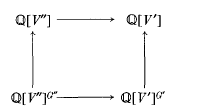No CrossRef data available.
Article contents
Invariant theory and Steenrod operations – maps between rings of invariants
Published online by Cambridge University Press: 24 October 2008
Abstract
Let G ′, G ″ be finite groups and p ′: G ↪ GL(n ′,ℚ), p ″: G ″ ↪ GL(n ″, ℚ) faithful rational representations. If T: V′ = ℚn′ → ℚn″ = V ″ is a linear transformation and Ξ: G ′ → G ″ a function such that

then there are induced algebra homomorphisms ℚ[V ″] → ℚ[V ] and ℚ[V ″]G ″ → ℚ[V ′]G ′ making the diagram

commute. In this note we isolate the invariant theory portion of [1] and extend it to provide a necessary and sufficient condition that an algebra homomorphism between rings of invariants ℚ[V ″]G ″ → ℚ[V ′]G ′ arises in this way.
- Type
- Research Article
- Information
- Mathematical Proceedings of the Cambridge Philosophical Society , Volume 120 , Issue 1 , July 1996 , pp. 103 - 116
- Copyright
- Copyright © Cambridge Philosophical Society 1996




